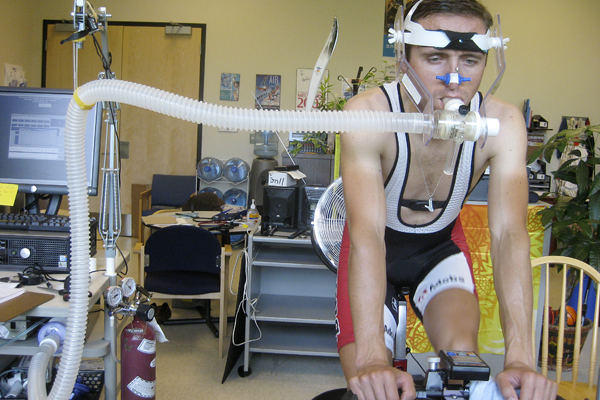Getting the best out of an athlete with the VO2 test
Photo credit: Jeff Werner
TORONTO (CUP) — The jocks and geeks of Ryerson University have found something to work together on. The school of nutrition and the varsity athletics department have partnered on a program to increase the efficiency of athlete exercise.
The Nutrition and Exercise Testing Lab (NExT) has state-of-the art equipment to find data that they can use to provide more accurate recommendations to athletes’ training schedules.
“At the end of the day, you have to train on a regular basis, but if you can train smart, then you’re going to end up with athletes who are better athletes,” says Nick Bellissimo, assistant professor at the school of nutrition.
Bellissimo has been working with Sam Walls, the strength and conditioning coordinator for the athletic department, on the pilot program. They run athletes through a few tests including the most important one, called the VO2 max test. VO2 is the rate at which your body uses oxygen.
Athletes are hooked up to a machine with a mask, which has two tubes running to a computer.
The athletes then run on a treadmill and every minute, the speed and incline of the treadmill increase. With the increased workload, the athlete’s breathing and heart rate rises.
“It’s a weird feeling, because your nose is plugged and you have the mask on,” says Keneca Pingue-Gilles , a fourth-year women’s basketball player. “It’s not really how you would play basketball.”
Walls says when the athlete crosses their peak heart rate, called the ventilatory threshold, they suddenly become really exhausted. So the heart rate can then be used to recommend how much exercise should be done.
“That’s a very valuable number,” he says. “Now we can take this information and be much more accurate in the prescription of their training program.”
In past years, Walls says he would recommend a percentage range for ideal heart rate based solely on the age of the athlete. Now, with each athlete getting their own specific number, his recommendations can be more beneficial to each person.
The program has only been tested on the women’s basketball team but Walls says they are looking to run the men’s soccer team through it soon. The main purpose of the pilot stage is to see how efficiently the VO2 test can be run.
Previously, athletes would be tested together with the beep test. They would all line up in the gym and run back and forth.
As athletes would hit their ventilator threshold they would stop running and the test would go until everyone had reached their peak. That test would take 15 minutes and cover everyone on the team.
The VO2 test can take up to 40 minutes per person. With close to 20 or more athletes per team, it could take up to a week for everyone to do the test.
Walls says that even though it may be time consuming, they are moving forward with the project.
“Our optimal vision is to have it where we test them right at the beginning of the season, and right at the end of the season, to end up seeing what particular qualities are lost, and what are maintained,” he says.
Bellissimo doesn’t run the tests himself; he lets his undergrad and graduate students get the experience.That way, both the athletes and the nutrition students get first-hand experience with technology used almost exclusively at the highest levels of sport.
Ryerson’s athletic director Ivan Joseph says any way an athlete can get an advantage in the third period or fourth quarter is worth pursuing.
For Pingue-Gilles and the other women’s basketball players, knowing they could get an advantage from these extra tests is exciting.
“It’s supposed to be hard but everything is analytical and statistics now,” she says. “I think it will help us get better.”






